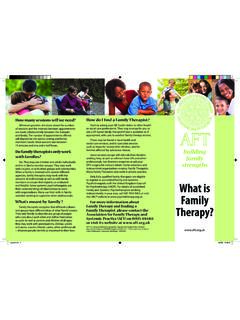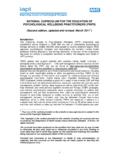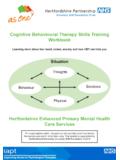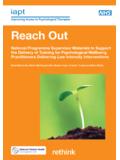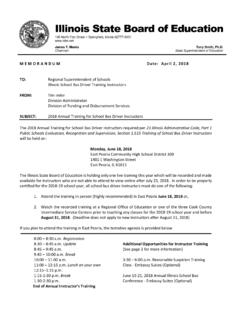Transcription of Outcome Rating Scale (ORS) - AFT
1 Version 17/01/12 1 The Outcome Rating Scales (ORS) & Session Rating Scales (SRS): Feedback Informed Treatment in Child and Adolescent Mental Health Services (CAMHS) Prepared for CYP-IAPT by: David C. Low, Norfolk & Suffolk NHS Foundation Trust, Scott D. Miller, International Center for Clinical Excellence (ICCE), Brigitte Squire, Cambridgeshire & Peterborough NHS Foundation Trust. Introduction Monitoring the young persons and carers feedback on progress with the Outcome Rating Scale (ORS) and the alliance with Session Rating Scales (SRS) is a natural fit for clinicians who strive for a collaborative clinical practice. The ORS and SRS gives young people and carers a voice in treatment as it allows them to provide immediate feedback on what is working and what is not. This section details how clinicians can use the ORS and SRS for real time feedback to inform treatment thereby improving the Outcome of services they offer to young people and families.
2 A brief overview of the empirical evidence of both scales, and the research of their combined use will be provided. In addition, the majority of this section will be practical and provide an introductory illustration to the use of the ORS and SRS throughout the therapy process. At the end you will be sign posted to how to access the measures and resources available to support your use of them. Key Evidence Base Findings Since the introduction of the ORS and SRS in 2000, research has progressed from instrument validation to randomized control trials (RCTs). Research on the ORS and SRS demonstrate impressive internal consistency and test-retest reliability (Miller et al., 2003; Duncan et al., 2003; Bringhurst et al., 2006; Duncan et al., 2006; Campbell & Hemsley, 2009). Version 17/01/12 2 In those studies the ORS and SRS show moderately strong concurrent validity with longer, more established measures of treatment Outcome and therapeutic alliance.
3 Feasibility ( the degree to which it can be explained, completed, and interpreted quickly and easily) of the ORS and SRS is high as they are ultra brief. As a result clinicians and clients don t mind using them and so their utilization rates are higher than other measures (Miller, et al. 2003; Duncan et al., 2003). If session by session measures do not meet the time demands of real clinical practice, clinicians and clients alike may use them with reluctance at best, and resistance at worse. Much of the fear and loathing involved in doing session by session measures is not there with the Outcome and Session ratings Scales as they usually take on average a minute for administration and scoring. Over 3000 young people participated in the four year validation study of the ORS with adolescents aged 13 -17, and the Child Outcome Rating Scale (CORS) for children aged 6-12 (Duncan, et al.)
4 , 2006). The ORS with the adolescents and CORS significantly correlated with the Youth Outcome Questionnaire (YOQ 30), and both showed robust reliability, validity and feasibility. Four studies, including three RCTs, support the efficacy of using the ORS and SRS as a client feedback intervention across various treatment approaches (Miller, et al., 2006; Anker et al., 2009, Reese et al. 2009a & 2009b). The three RCT's and several quasi-experimental studies to date provide ample evidence that routine use of the scales improves retention and Outcome (in terms of functioning) while decreasing deterioration, length of stay and costs. Shortly, the ORS & SRS: Feedback Informed Treatment (FIT) will receive designation as an evidence-based practice by the federal government. ORS and CORS The ORS is a simple, four-item session by session measure designed to assess areas of life functioning known to change as a result of therapeutic intervention (see appendix).
5 To encourage a collaborative discussion of progress with clients, Miller and Duncan (2000) developed the ORS as an ultra brief alternative to longer measures whose length of administration, scoring, and interpretation made them less practical. The ORS assess Version 17/01/12 3four dimensions of client functioning that are widely considered to be valid indicators of successful Outcome (Lambert et al., 1996): 1. personal or symptom distress (measuring individual well being). 2. interpersonal well-being (measuring how well the client is getting along in intimate relationships) 3. social role (measuring satisfaction with work/school and relationships outside of the home). 4. overall well being. The ORS translates these four dimensions of functioning into four visual analogue scales which are l0cm lines, with instructions to place a mark on each line with low estimate to the left and high to the right (see appendix).
6 The ORS rates at a 13 year old reading level, making it feasible for adolescents and adults. Clients are asked to fill in the ORS at the beginning of each session. The Child ORS (CORS) was developed for children age 6-12 (see appendix). It has the same format as the ORS but with more child friendly language and smiley and frowny faces to facilitate the child s understanding when completing the scales (Duncan et al., 2003). Some young teens might prefer the CORS format over the ORS. You can use your clinical judgment here to consider which version will engage the young person the best. So, some teenagers might fill in the CORS and some older children may fill in the ORS. For children 5 or under there is also Young Child Outcome Rating Scale (YCORS) which has no psychometric properties but can be a useful way of engaging small children regarding their assessment of how they are doing (see appendix).
7 Other Ways the ORS is Different One source of potential confusion is that the ORS/CORS, unlike other measures, is not designed to predict what diagnosis a young person is likely to have, nor is it measuring symptom reduction. The research makes it clear that people do not seek, or stay in services when they experience symptoms, but rather when those symptoms begin to impact on their functioning (Hill & Lambert, 2004). The purpose of the ORS/CORS is to provide real time feedback on progress in client functioning. Version 17/01/12 4 The ORS also has a Reliable Change Index (RCI) that provides a useful guide to help identify when change is clinically significant and attributable to therapy rather than chance. On the ORS the RCI = 5 points. So, change that exceeds the RCI and crosses the clinical cut off scores can be considered reliable change.
8 Most important, unlike other existing measures, the ORS provides session by session predictive trajectories to let clinicians know at a given session if their client is at risk of drop out or negative Outcome . To help make this clinical judgment, the client s current ORS scores can be compared to similarly scoring individuals in treatment. Deciding Who Fills out the ORS/CORS If two clinicians from a multi disciplinary team are separately seeing the young person and carers within the same week, you will need to decide between you who will be administering the ORS/CORS. Where is the Distress? The ORS/CORS is designed to assess distress and help measure progress. So in deciding who in the family is to fill out the ORS/CORS, ask yourself: Where is the distress? In most first interviews you won t know where the distress is, so you can ask all family members to complete the measures on themselves to see who is distressed.
9 Child and Young Person The young person who is referred or is seeking help, is always asked to fill out the ORS (ages 13 to 18) or CORS (ages 6-12) on themselves. Carer The carer is always asked to complete the ORS/CORS on the young person. For instance, if the young person is 13 or over and fills out the ORS, the carer fills out the ORS on how they perceive the young person doing. Similarly, if the young person is 12 and under and fills out the CORS, than the carer fills out the CORS on the young person. Even if the carer is invited to fill out the ORS on themselves, they still fill out the ORS or CORS on the young person. Carer and/or Other Family Members who are Distressed If it turns out that the carer and/or other family members are distressed, and the distress is related to problems in the family (including the child), then you can continue to have the Version 17/01/12 5carer and family members filling out the ORS/CORS on themselves.
10 Your plan and approach should consider how those individual family members needs will be met. If the distress of a carer seems separate and/or beyond what your service can provide, discuss and plan with the carer what individual services they would find beneficial. Teachers and Other Professionals Teachers or other professionals closely involved, and who can attend periodic meetings, can also be asked to fill out the ORS/CORS on the young person. Mandated or Involuntary Clients Mandated or involuntary clients, who frequently present as not distressed or report they have no problem, can be asked to fill out the ORS/CORS from the point of view of the person who is distressed and who has concerns for them. Similarly, you can ask them to fill the ORS/CORS from the perspective of the referrer who has concerns about how they are doing. At the same time, ask the client to fill out the ORS/CORS on themselves, with the rational that you want to make sure that whatever you do together doesn't impact their stated functioning negatively.
